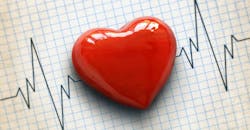Study Shows Benefits Outweigh Risk of Contracting COVID from CPR
When it comes to saving someone's life during a cardiac episode, every second counts.
Researchers recently studied the risk of contracting COVID-19 while providing cardiopulmonary resuscitation (CPR) and discovered that the fatality rate is significantly lower compared to the number of victims who succumb to heart attacks each year. The letter appeared in the American Heart Association's (AHA) journal Circulation.
"Resuscitation of patients in out-of-hospital cardiac arrest (OHCA) depends on rapid, coordinated efforts involving laypersons, telecommunicators, prehospital professionals and hospital providers," the AHA says. "However, during the pandemic, experts have questioned whether chest compressions are a high-risk “aerosolizing” procedure that could increase the risk of COVID-19 infection, especially since bystander CPR is typically provided for only a few minutes."
The letter titled "Prevalence of COVID-19 in Out-of-Hospital Cardiac Arrest: Implications for Bystander CPR" considered data generated between January 1 and April 15, 2020, focusing on a COVID-19 period between February 26 and April 15. It found that performing bystander CPR is a lifesaving measure whose benefits greatly outweigh the risks of contracting the novel coronavirus.
It focused on University of Washington EMS physicians and researchers in Seattle and King County, Wash., analyzing emergency medicial services (EMS) and hospital treatment data, and death certificates of all OHCAs to estimate the instance of infection among the total out-of-hospital cardiac arrest population served during that time period.
While the Seattle community had 15 deaths per 100,000 population from COVID-19, researchers estimate only 1 rescuer per 10,000 bystander CPR events will succumb to the virus.
Researchers assumed the risk of transmission to bystanders performing hands-only CPR without personal protective equipment (PPE) is 10%, which means that 1 bystander out of 100 would potentially contract COVID (10% with COVID-19 x 10% transmission).
The authors explain: "We believe the current findings support telecommunicators and bystanders maintaining the most efficient approach that prioritizes rapid identification of cardiac arrest and immediately proceeds to chest compressions and use of a defibrillator. Delaying bystander CPR to [put on personal protective equipment] should only be considered when the prevalence of COVID-19 infection is substantially increased.”
During the 105-day period, EMS responded to 1,067 out-of-hospital cardiac arrests of which 478 were treated with CPR. The COVID-19 outbreak was pinpointed between February 26 and April 15. According to the letter, EMS responded to 537 (50.3%) out-of-hospital cardiac arrests, of which 230 (48.1%) were treated with CPR during that time. COVID-19 was diagnosed in less than 10% of out-of-hospital cardiac arrests.
According to the AHA, bystander CPR saves more than 300 additional lives among 10,000 patients with out-of-hospital cardiac arrest. The association provided a novel coronavirus mortality rate of 1%.
Authors of the paper are Michael R. Sayre, M.D.; Leslie M. Barnard, M.P.H.; Catherine R. Counts, Ph.D., M.H.A.; Christopher J. Drucker, Ph.D.; Peter J. Kudenchuk, M.D.; Thomas D. Rea, M.D., M.P.H.; and Mickey S. Eisenberg, M.D., Ph.D. Disclosures are in the manuscript.
About the Author

Stefanie Valentic
Stefanie Valentic was formerly managing editor of EHS Today, and is currently editorial director of Waste360.
